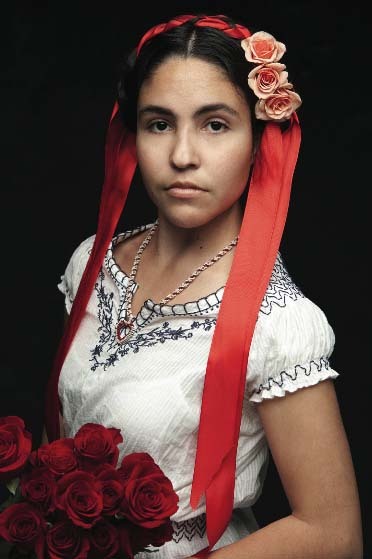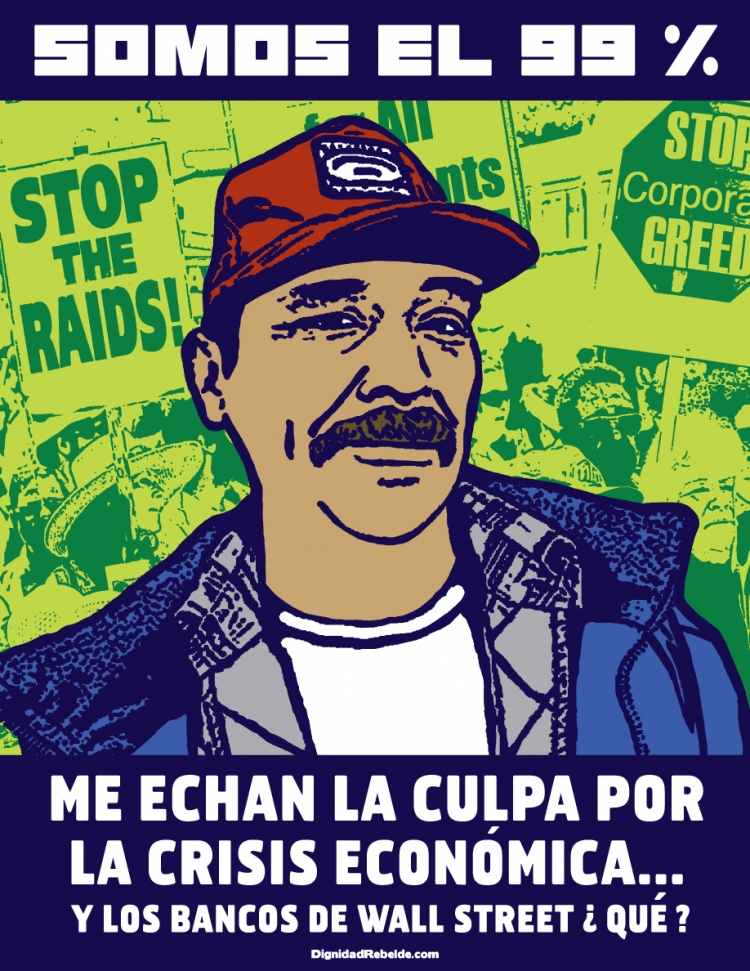Latinos in the U.S.: the assault on Chicana/o studies by Denise Oliver Velez was posted on the Daily Kos Blog. It was very motivating, a reminder why we must keep strong and protect the knowledge fought for us.
Latinos in the U.S.: the assault on Chicana/o studies
by Denise Oliver Velez
Academics, students and members of communities of color across the U.S. should be paying close attention to the concerted assault being waged right now in Arizona against its ethnic studies programs. Those of us who weathered the battles of the late ’60s and ’70s for the establishment of disciplines like Black studies, Puerto Rican and Latino Studies, Asian and Native American Studies must come together to defend and expand those critical programs and departments that serve and educate, and who have expanded history and culture to include those of us who have been marginalized and never part of the official canon.
As the racist blacklash heightens in the U.S. from right-wing elements in our society—including in our system of education—those of us who teach, educate and organize must once again fight back to keep the doors, so recently opened, from closing. If we acknowledge that the U.S. is a nation made up of diverse peoples, with multiple his-tories and her-stories, we cannot fail to support the struggles of one of the largest minority groups in our nation—those citizens of Mexican heritage—to be included as a critical part of who we are today, where we came from and where we are going.
To understand where we are today, we must first examine the history of the development of Ethnic Studies, which was not simply a new academic discipline, but is part of a broader movement for social change and justice in U.S. society.
In the United States, the field of Ethnic Studies evolved out of the civil rights movement in the late 1960s and early 1970s, which saw growing self-awareness and radicalization of people of color such as African-Americans, Asian Americans, Latino Americans, and American Indians. Ethnic Studies departments were established on many campuses and grew to encompass African American Studies, Asian American Studies, Raza Studies, Chicano Studies, and Native American Studies. The first strike for Ethnic Studies occurred in 1968, (led by Third World Liberation Front, a joint effort of the Afro-American Student Association, Mexican American Students Confederation, Asian American Political Alliance, Pilipino American Collegiate Endeavor, and Native American Students Union at San Francisco State University); it was the longest student strike in the nation’s history, and resulted in the establishment of a School of Ethnic Studies, when President S.I. Hayakawa ended the strike by taking a hardline approach, appointed Dr. James Hirabayashi the first dean of the School (now College) of Ethnic Studies at San Francisco State University, and increased recruiting and admissions of students of color in response to the strike’s demands. In 1972, The National Association for Ethnic Studies was founded to foster interdisciplinary discussions for scholars and activists concerned with the national and international dimensions of ethnicity.Berkeley also conceded and President Hitch approved a department of Ethnic Studies in 1969.
Courses in Ethnic Studies tried to address the criticism that the role of Asian Americans, Blacks, Latinos and Native Americans in American history was undervalued and ignored because of Euro-centric bias. Ethnic Studies also often encompasses issues of gender, class, and sexuality. There are now hundreds of African American, Asian American, and Latino Studies departments in the US, approximately fifty Native American Studies departments, and a small number of comparative Ethnic Studies programs. Ethnic Studies as an institutional discipline varies by location. For instance, whereas the Ethnic Studies Department at UC Berkeley comprises separate “core group” departments, the department at UC San Diego does not do so.
Chicana/o Studies, as a large part of the category of Ethnic Studies, is a crucial component of this new field. A simple look at the Mexican American demographics should make it clear why the education system needs to respond to this community.
As of July 2009, Mexican Americans make up 10.3% of the United States’ population with over 31,689,000 Americans listed as of Mexican ancestry. Mexican Americans comprise 66% of all Hispanics and Latinos in the United States. The United States is home to the second largest Mexican community in the world second only to Mexico itself comprising nearly 22% of the entire Mexican origin population of the world.
Given the fact that this population is significantly younger than many other ethnic groups, with a growing number of children in the school systems across the US, it is also clear why there was a movement to develop Chicana/o studies, as more young Mexican-Americans entered schools that did not meet their needs.
The major thrust for Chicano Studies came within the context of the African-American civil rights struggle. During this period, Mexican American educators demanded that colleges and universities address the pedagogical needs of Mexican American students who the schools were failing. Major themes were bilingual education and the building of positive self-images. In 1967, a student collective at the University of California, Berkeley (Cal) began publishing El Grito: A Journal of Contemporary Mexican American Thought. About three years later, students and faculty at University of California, Los Angeles (UCLA) began publishing Aztlán: A Chicano Journal of the Social Sciences and the Arts. These publications define the interdisciplinary nature of Chicano Studies. Chicano Studies programs and departments were born out of the struggle. The formation of the United Mexican American Students (UMAS) in California and the Mexican American Youth Organization (MAYO) were major catalysts. Exploratory programs were developed at California State College, Los Angeles (CSCLA) now California State University, Los Angeles (CSULA) in 1968 and at California State University, Fresno (Fresno State). At the height of the Chicano student movement that spawned the Chicano Blowouts, (a massive student boycott to protest unfair conditions in Los Angeles Unified School District schools). CSULA established the nation’s first Chicano Studies department in 1968.
By the mid-1970s, Chicana feminists challenged the masculine domination of the field, making gender issues central to the concerns of the academic community. After intense struggle at the National Association for Chicano Studies the name of the association was changed to Chicana/o Studies, underscoring that Chicanas were equal partners in the area of Chicana/o Studies. The need for Chicano and Chicana Studies have increased since 1969. In 1970 there were about 9 million Latinos of which 5.5 million were of Mexican extraction… The resurgence of Chicano student activism in the early 1990s begot a major Chicano Studies Department. UCLA’s MEChA Chapter took a leadership role and protested an attempt by the UCLA Administration to eliminate the Chicano Studies Program. After a three year struggle, led by MEChA and the The United Community and Labor Alliance (a coalition of Mexican American activists and community leaders, labor union representatives, and immigration advocates in Los Angeles), a hunger strike in 1993, involving student activists, community supporters and a UCLA faculty member resulted in the establishment of a Center for Interdisciplinary Instruction in Chicana/o Studies at UCLA. The Center later named after United Farmworkers leader Cesar Chavez transitioned to a full fledged campus department in 2004…In May 2010, the Governor of Arizona signed House Bill 2281 which bans all ethnically exclusive forms of state-funded teaching in the state. Chicano Studies will be disbanded in state-funded schools effective on January 1, 2011.
One of the most powerful voices has come from students who organized the Movimiento Estudiantil Chicano de Aztlán, now known as Movimiento Estudiantil Chican@ de Aztlán (M.E.Ch.A.)
In March of 1969, at Denver, Colorado the Crusade for Justice organized the first National Chicano Youth Liberation Conference that drafted the basic premises for the Chicana/Chicano Movement in El Plan de Aztlán. The following month, in April of 1969, over 100 Chicanas/Chicanos came together at University of California, Santa Barbara to formulate a plan for higher education: El Plan de Santa Barbara. With this document they were successful in the development of two very important contributions to the Chicano Movement: Movimiento Estudiantil Chicano de Aztlán (MEChA) and Chicano Studies.
MEChA and other Chicano/a groups cannot win the current battle to preserve the hard-won victories of the past alone.
What was won is now being assaulted and eroded. I would suggest that a good starting place to understand where we are today is the new documentary film Precious Knowledge.
Precious Knowledge, documentary
Precious Knowledge interweaves the transformative stories of seniors in the Mexican American Studies Program at Tucson High School. Inequalities in education continue to affect people of color. The ticking time bomb story of our time is that fewer than six in 10 Latino adults in the United States have a high school diploma. These alarming dropout rates will continue to have a serious impact on our nation. Our documentary goes further, however, by illustrating forms of critical pedagogy that can empower Latino youth and other youth of color and change this state of affairs. Precious Knowledge will illustrate to a nationwide audience a Mexican American Studies program that inspires 82% of its students to enroll in college. The themes of Precious Knowledge are embedded in the journey of each student as they: self reflect, seek out precious knowledge, begin to act, and ultimately transform, while nurturing positive images of Latino identity and embracing the dignity of all cultures and histories.
I’ve heard many people from my generation complain that today’s young people are not engaged in activism. Nothing could be further from the truth. It just isn’t going to get coverage in the traditional media.
See this video of activist students taking over a school board meeting in Tucson back in April.
Student protesters from the Mexican American Studies (MAS) program take over a scheduled Tucson Unified School District board meeting (04/26/11) at which a resolution was to have been voted for that they felt would destroy their program. As the meeting was about to start, 9 students rushed the front of the room and occupied board members chairs, chaining themselves to the chairs. For several hours the standoff continued before it was announced that the meeting was cancelled.
TUSD’s MAS program has been under attack since the Arizona legislature passed HB 2281 in 2010 — a law that outlaws such programs in the state. A group of MAS teachers filed suit against that law. The suit is pending.
It is important that we note that this effort is not just about Arizona’s House Bill 2281. Texas has also undertaken a draconian revision of its social studies curriculum.
The New York Times reported last year in Texas Conservatives Win Curriculum Change:
AUSTIN, Tex. — After three days of turbulent meetings, the Texas Board of Education on Friday approved a social studies curriculum that will put a conservative stamp on history and economics textbooks, stressing the superiority of American capitalism, questioning the Founding Fathers’ commitment to a purely secular government and presenting Republican political philosophies in a more positive light. The vote was 10 to 5 along party lines, with all the Republicans on the board voting for it.
The board, whose members are elected, has influence beyond Texas because the state is one of the largest buyers of textbooks. In the digital age, however, that influence has diminished as technological advances have made it possible for publishers to tailor books to individual states.In recent years, board members have been locked in an ideological battle between a bloc of conservatives who question Darwin’s theory of evolution and believe the Founding Fathers were guided by Christian principles, and a handful of Democrats and moderate Republicans who have fought to preserve the teaching of Darwinism and the separation of church and state.
Since January, Republicans on the board have passed more than 100 amendments to the 120-page curriculum standards affecting history, sociology and economics courses from elementary to high school. The standards were proposed by a panel of teachers.
“We are adding balance,” said Dr. Don McLeroy, the leader of the conservative faction on the board, after the vote. “History has already been skewed. Academia is skewed too far to the left.”
Balance? Bulls**t is more like it.
History? Whose story? Texas gives lesson in revision
Millions of Texas students head back to school this week confronted by a dramatically altered, state-mandated social studies curriculum. The contentious hearings of the Texas State Board of Education received considerable attention in the spring of 2010, but seem to have fallen out of the public consciousness as the new school year begins. The new curriculum, officially called the Texas Essential Knowledge and Skills, deserves renewed attention, as it will undoubtedly surprise most Texans.
The fiercest battle during the board’s hearings was fought over the 11th-grade history curriculum, which in Texas is “United States History since 1877.” The exception to that timeline is the new state-mandated “Celebrate Freedom Week,” during which students will learn about our founding fathers. That sounds simple enough, except that the only founding fathers included in the curriculum are Benjamin Rush, John Hancock, John Jay, John Witherspoon, John Peter Muhlenberg, Charles Carroll and Jonathan Trumbull Sr. What about George Washington, Thomas Jefferson or John Adams? They are nowhere to be found in the new high school TEKS. Students apparently learned everything they need to know about them in eighth grade.
As part of the board’s effort to emphasize the positives in American history, students will no longer learn about “American imperialism.” Instead students will discuss “American expansionism” and come to understand how “missionaries moved the United States into the position of a world power.”
Thanks to ethnic studies programs and curricula, some students will learn that we had founding fathers and mothers who were not monochromatic, nor were they all conservatives.
TAKE ACTION
There are a number of ways you can get involved and take action. First stop is Save Ethnic Studies.org.
Elected officials like Congressman Raul M. Grijalva and many groups of progressives are now engaged.
Plans are being made for a second annual Support Ethnic Studies Week, Oct. 1-7 nationwide.
Please join up!
The first Ethnic Studies Week October 1-7, 2010 was inspired by opposition to the May 11 2010 passage of HB 2281 in Arizona banning ethnic studies in the AZ public schools and the May 21 2010 passage of new social studies standards by the influential Texas State Board of Education. It was initiated by 225 educators, endorsed by educational and activist organizations around the country, and open to all who wanted to participate, as hundreds did in individual K-12 and college classrooms,where students, listened to speakers, watched films and paused to reflect on the importance of ethnic studies. Public events occurred in dozens of venues in San Diego, Long Beach, Los Angeles, San Francisco, and Watsonville California; Greeley, Boulder and Denver Colorado, Salem and Seattle Oregon, Laramie Wyoming, Tucson, Prescott, Phoenix, and Tempe Arizona; Albuquerque New Mexico, Lincoln Nebraska, Honokaa Hawaii, Minneapolis, St Paul, and St Cloud Minnesota, Madison Wisconsin, Chicago Illinois, Gary Indiana, Gainesville Florida, Middletown Connecticut, Bridgewater and Marthas Vineyard, Massachusetts, Long Island , New York City, and Poughkeepsie New York, El Paso and Austin Texas, Albion Michigan, and more.
Pa’lante Siempre Pa’lante

















